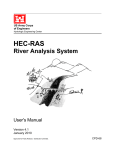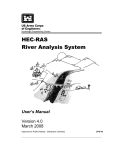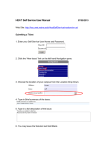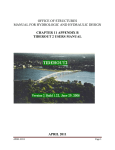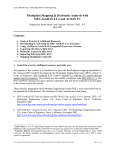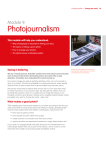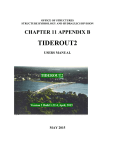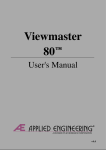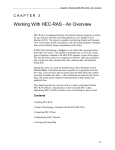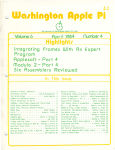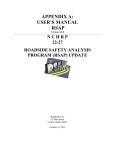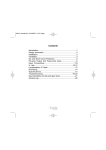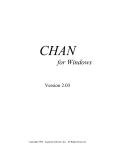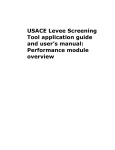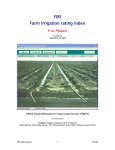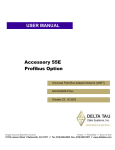Download HEC-RAS 3
Transcript
HEC-RAS 3.0 January, 2001 Release Notes A new version of HEC-RAS (3.0) has been released with significant new features over the previous version (2.21). Version 3.0 includes unsteady flow routing capabilities, as well as several new features for steady flow water surface profile computations. The following is a list of the new features that have been added: A. Unsteady Flow Routing Features 1. Unsteady Flow Data Editor – This editor allows the user to enter boundary conditions and the initial state of the system. Boundary conditions consist of stage and flow hydrographs, rating curves, gate settings, etc… See Chapter 8 “Performing an Unsteady Flow Analysis” for details. 2. Unsteady Flow Simulation Manager – This simulation manager allows the user to set up an unsteady flow simulation. The user is required to define a plan, establish a time window, and select several other computational options. See Chapter 8 “Performing an Unsteady Flow Analysis” for details. 3. Geometric Pre-Processor (HTAB) – The geometric preprocessor converts the geometry data into a series of tables and rating curves. This is done in order to speed up the unsteady flow calculations. Cross sections are converted to tables of elevation versus area, conveyance, and storage. Bridges, culverts, and weirs are converted into a family of rating curves that describe headwater, tailwater, and flow rate. See Chapter 8 “Performing an Unsteady Flow Analysis” for details. 4. Output Post-Processor – The post-processor is used to calculate detailed hydraulic information for a set of user specified time lines during the unsteady flow simulation period. The post-processor takes the computed flows and stages from the unsteady flow model and calculates all of the hydraulic 1 variables required for detailed output. By running the postprocessor, the user will have all of the available plots and tables for unsteady flow that HEC-RAS normally produces for steady flow. See Chapter 8 “Performing an Unsteady Flow Analysis” for details. B. 5. Stage and Flow Hydrograph Plots – We have added the ability to plot and tabulate both stage and flow hydrographs. The plot allows the user to plot just stage, just flow, or both. You can also plot observed data, if you have it in a HEC-DSS file. 6. Graphics Animation – We have added the ability to animate the cross section, profile, and 3 dimensional graphics. Animation consists of stepping through the computed results based on a user specified output interval. Try it out, its fun!!! 7. UNET Data Importer – We have added the ability to import the geometry data from a UNET model (CSECT files). This option is available from the File menu of the Geometric Data Editor. At this time we have not added the ability to import UNET boundary condition files. Sorry, maybe for the final Version 3.0. New Geometric Data Features – The following is a list of the new features that can be found in the Geometric Data Editor. These features work for both unsteady flow and steady flow computations. 1. Lateral weirs and gated spillways – Lateral weirs and gated spillways allow the user to remove flow from the main river through gated structures or uncontrolled over flow weirs. Lateral weirs and gated spillways can be connected to a storage area or another river reach. 2. Lateral rating curves – This option allows the user to enter elevation vs. flow rating curve for flow leaving the main river. A lateral rating curve can be used to send flow to another reach or the flow can just leave the system without being connected to something else. 2 3. Storage areas – Storage areas are used to define an area where water will pond (i.e. no significant conveyance in the downstream direction). They are often used to model off channel storage or an area behind a levee. 4. Hydraulic Connections – Hydraulic connections are used to pass flow between storage areas or between a storage area and another reach through the use of culverts and/or a weir. Hydraulic connections consist of a weir, culverts and a weir, or gated spillways and a weir. 5. Cross Section Points Filter – This editor allows the user to reduce the number of points in a cross section by using a near point filter and a collinear line filter. The near point filter allows the user to set a vertical and horizontal tolerance. If two points are within both the vertical and horizontal tolerance, then the second point is removed. A collinear line filter allows the user to enter a vertical distance tolerance and a slope tolerance. The program takes three points in a row, puts a straight line through the first and third, then checks to see the vertical distance between the line and the second point. If the distance is less than a pre-defined value, and removing that point will not change the line slope more than a pre-defined amount, then the point is removed. 6. CONSPAN Culvert Shape – We have added a new culvert shape called a CONSPAN culvert. This culvert shape is a prefabricated concrete culvert that has a natural bottom. These culvert shape are very good for fish passage and other environmental factors. 7. Buried Culverts – you can now specify a depth buried inside of any culvert. This allows the user to model culverts that are buried on purpose, as well as culverts that have sediment deposits. 8. Multiple Manning’s n Values in Culverts – The user can now enter separate Manning’s n values for the culvert bottom versus the culvert sides and top. 3 C. 9. Sediment Elevations – We have added the ability for the user to specify a depth of sediment in any cross section. Sediment depths can be entered over a range of cross sections by projecting the sediment on a slope, or by specifying the depths at the two ends and interpolating in between. 10. Pilot Channels – This is a feature that is used in unsteady flow routing. For reaches that have shallow flow and are experiencing stability problems. A pilot channel can be added to increase the depth seen by the numerical solution, which intern improves stability of the solution. 11. Permanent Ineffective Flow Areas – this option allows the user to set an ineffective flow area to permanent. This means the area will stay ineffective, even after the water surface rises above the top elevation of the ineffective flow. This was mainly added for unsteady flow, but can also be used in steady flow. For unsteady flow, some times when a large ineffective flow area goes from ineffective to completely effective, instabilities would occur in the solution. 12. Bridge Skew – User can now enter skew angles for bridge decks/roadways and bridge piers, the HEC-RAS program will then adjust the bridge opening and pier widths accordingly. The cross sections that bound the bridge can also be adjusted automatically for skew. Split Flow Optimization We have added the ability to perform split flow optimization in the steady flow water surface profile computation program. This option allows for flow splits at junctions, as wells lateral weirs and gated spillways. This is an option the user must turn on from the steady flow analysis window. The user is required to enter an initial estimate of flows in all of the reaches, and then the program will optimize the split of flow through an iterative scheme of computing profiles and evaluating flow splits. More information on this can be found in example 15 of the applications guide. Example 15 was printed as supplemental documentation for Version 3.0 beta. 4 D. HEC-GeoRAS HEC-GeoRAS 3.0 is a new application for support of HEC-RAS using ArcView GIS. GeoRAS allows engineers with limited geographic information systems (GIS) experience to develop geometric data for import into HEC-RAS and to process results exported from HEC-RAS. You must have the ArcView GIS 3.1 software with the 3D Analyst extension to use GeoRAS. Included on the CD are the HEC-GeoRAS ArcView extension and users documentation. See Chapter 2 of the GeoRAS User’s Manual for installation instructions. E. Bug Fixes Since Version 2.21 (including bugs in the 3.0 beta version) 1. XS Editor - The menu item for ice cover, once checked was staying checked for other XSs sometimes even when there is no ice cover information. 2. Graphical XS Editor. There was a bug that crashed the application when users did the following: Add a normal ineffective area Add a blocked ineffective area Attempt to move the normal ineffective area 3. Steady Flow Data Editor - Last data entered in the grid text editing box was not saved. The grid text editing box is activated by pressing F2 or double-clicked the mouse on the grid. If the flow is changed and the window was closed, then the data for this one cell will not be saved. The text editor can be used to edit data, but the user would have to change the focus to another cell before the data would be saved. Note, this only happen if you double click or press F2. 4. DSS plots and tables with weekly time interval data might not have worked. 5. Printing Profile Tables - If the option to print gray headers is unchecked, the program did not print the variable headers at all. 6. Geo-referencing data is now converted when the project units are converted. 7. Right Levee elevations - When a right levee was entered without an elevation at the station of a vertical wall, the elevation would be computed at the bottom of the wall. This has been changed to the top. 8. GIS Bounding Polygon - The bounding polygon did not recognize a levee at the start or end of a cross section as a constriction. 9. Pressing Delete in an empty plan or profile list caused program to crash. 5 10. DSS Plots - Plot did not work for dates before 1900. 11. Printing from the bridge and culvert editor with a user-defined scale did not work properly. 12. GIS Import - When the bank stations are set to 0,0 in the import file, RAS would duplicate the first point. 13. Plotting Culvert Rating Curves. RAS used to get the invert from the first culvert in the output file, now it finds the culvert with the lowest invert. 14. Printing Multiple Culvert Tables. RAS would only print the first culvert even if there were multiple culverts in the data. 15. Profile plot plan comparison. An error occurred if the reaches did not have the same downstream river station. 16. Selecting a new printer - from the print dialog, users could select a different printer than the current, but the selection would not be used in printing. 17. Profile plots of ice though bridges - The upstream and downstream ice elevations were swapped on the plot (but not in computations). 18. Encroachments - A subscript out of range error occurred if there were more profiles in flow data than in the encroachment data. For example the flow data could have 4 profiles, but the encroachment data only covers profile 2 and 3, this would cause the error. 19. Report Generator with Culverts of type: Semi-circle and high arch cause report generator to fail. 20. Importing a river reach from a HEC-RAS file and adding them to an existing system sometimes caused cross sections from other reaches to be added to the new reach. 21. Cross Section Interpolation - Could not interpolate with a distance less than 1 foot. (This has been there since the beginning). 22. Inundation Bounding Polygon had problems with culverts. flow that is not directly over the culvert barrels. In particular culverts with weir 23. Connecting reaches to storage areas as an upstream boundary condition caused the reach line to be deleted. 24. Culvert Specific Output Table - Lists the culvert control criteria "inlet" or "outlet". There was a bug added in the first 3.0 beta version. 25. DSS Project Specific Text was not getting reset to blank when loading another project. This caused the first text entered to perpetuate into all subsequent projects. 26. DSS Viewer - The "Plot Selected Pathname(s)" button was modified to "Plot/Tabulate Selected Pathname(s)" to reflect the changes in 3.0 that plot and tabulate two tabs in one window. 27. Unsteady Post Process did a split flow optimization. If a plan was a steady flow plan with split flow optimization and it was converted to an unsteady plan then it would perform the optimization on post process. This has been changed to not perform the split flow optimization. 6 38. Lateral Weir Flow Computation Criteria - The program did not save the option, so it always defaulted back to using the water surface as the for reference weir flow computations. 39. Scour Computations - The contraction scour widths W1 and W2 used to use the full top widths, but were changed to use the active top widths to exclude the ineffective flow areas. 30. Scour Computations - The computation of abutment scour requires an abutment projection length L'. This parameter used to be computed as the difference from the abutment toe station and the water surface intersection with the ground in the cross section immediately upstream of the bridge. Now it is computed as width of the active flow area in the approach section that is used to compute Qa and Ae. In addition the active width that was used to compute Ya, there was an error in computing that would over estimate the active width, possibly as much as one velocity subsection width. 31. River Mile locations in the DSS Plot Table were displayed to only 2 decimals. If the units are "MILES" then RAS displays this column with 3 decimals 32. DSS View form displays the path and file of the current DSS file. This field was fixed in width and would not display a long path name. The dropdown combo box now expands to fit the available width of the window. 33. Flow Stage Plotter for unsteady flow. In original Beta 3.0, RAS did not compare plans in this viewer. 34. More lines are available in the errors warning and notes list on the cross section output table. 35. Renumbering the river station table asked users if they wanted to copy the existing RS to the cross sections description the first time that cross sections were renumbered, but not on subsequent reaches. 36. DSS Viewer - If the window was opened and minimized and the user pressed the DSS Viewer button on the main RAS form the window did not get maximized. This left the user wondering where the DSS Viewer was at, and why the button appeared to not function. 37. Summary of Errors warnings and notes were incorrect and arbitrary for culverts. 38. An additional check was added to pre-computations for culverts, which makes sure the distance above a culvert barrel + barrel length is not greater than the distance between bounding cross sections. 39. The check box for equal conveyance reduction for encroachments did not work. The program would always go to equal conveyance calculations. 40. Closing the Lateral weir editor when the lateral gate or lateral deck editors where open would cause the program to crash. 41. Storage areas can now be moved graphically as a unit on the geometric schematic editor, rather than at one point at a time. 42. When attempting to enter cross section data before a river station has been entered on the cross section editor, a message box appears informing the user that the River, Reach and RS must be set. There was a bug in that the message would appear twice, if the user was trying to enter station elevation data. 43. Pressing the Help button the Culvert Editor caused the program to crash. 7 44. The photo viewer was modified so that it does not distort photos when in the stretching mode. 45. There was an error saving multiple type of boundary conditions in steady flow with certain arrangements of multiple reach systems. 46. The river reach line on the schematic editor did not show up when there were more then ~10,000 points on the windows 9x versions. 47. There was a problem with encroachments after a river was deleted from the geometry. 8








